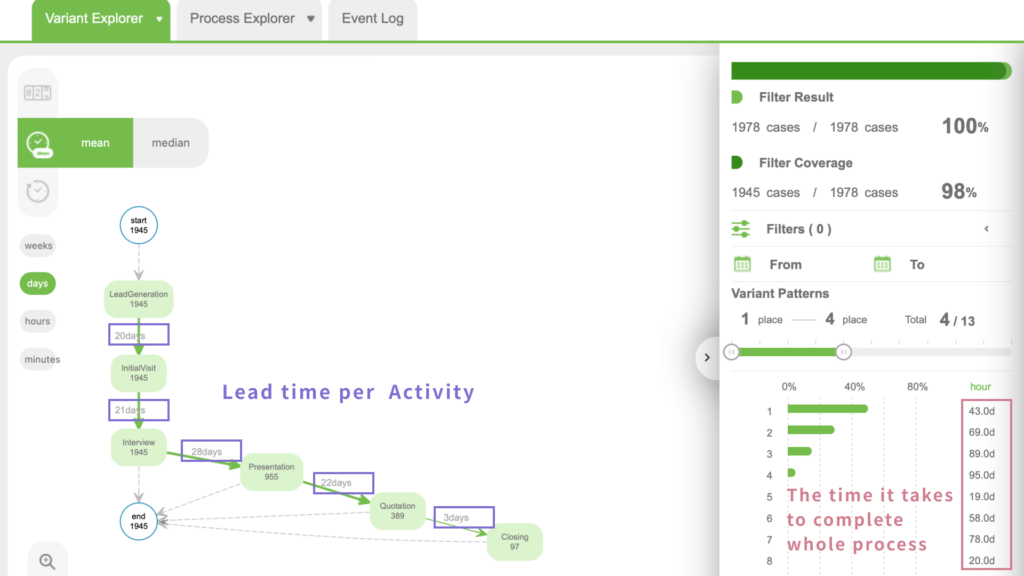Process mining can be applied to a wide range of business processes. In this article, we will present a picture of how process mining can be used to improve sales processes through the use of process mining. In the sales process, it is often the process from lead acquisition to closing that is used for analysis. Let’s find out problems that can be solved through process mining.
Sales Process Challenges
Because sales is directly linked to business performance, the process is a high priority for companies to improve. On the other hand, sales strategies change on a case-by-case basis, depending on external factors such as market fluctuations and customer size. And the process itself is often driven by intuition and experience. This makes it difficult to develop optimal strategies, identify bottlenecks, and standardize processes.
Here are some examples of problems in sales operations.
- Failure to understand whether sales are performing according to the ideal flow
- Inability to design a sales process that works for each customer
- Time consuming, leading to under-resourcing and poor performance
Approaches to Each Problem
Here are some ideas on how process mining can be used to derive solutions to each problem.
Analyzing the gap between ideal and actual processes
- Failure to understand whether sales are performing according to the ideal flow
- Inability to design a sales process that works for each customer
The best way to deal with such issues is to visualize the ideal sales process flow in concrete terms and visualize “how much it deviates from the actual sales process” and “what are the differences”. Process Mining can be used to visualize the business flow in a diagrammatic way”. Using the “Variant Explorer” function, it is possible to visualize which work patterns are common and to learn the patterns of sales processes that are frequently used in actual operations. It is a good idea to analyze whether this process is consistent with the ideal process. Some process mining tools also have a “conformance” feature that allows you to manually set the ideal process pattern and then show you what percentage of the actual process deviates from the ideal and what trends are common in the deviating processes. This functionality can be used to create a realistic sales process. By repeatedly modifying the real sales process with this functionality, you can improve the sales process and expect to increase the efficiency of your sales process and increase the number of sales.
Reduce cycle time
- Sometimes too much time is spent on a single sales call.
- Resource constraints lead to performance degradation
To address these issues, it is a good idea to visualize the actual time spent in the sales process and analyze the time spent in the sequence of events from lead acquisition to close or abandonment.
Using a process mining tool, it is possible to visualize not only the elapsed time for each step in the process, but also the lead time for each task.

A project using process mining often follows the following flow to improve the efficiency of operations
- Determine the scope of operations to be improved (e.g., reduce lead time from lead acquisition to close)
- Identify areas for improvement (e.g., speeding up the lead acquisition process)
- Set key KPIs and monitor and improve them on an ongoing basis (e.g., set targets from lead acquisition to first visit and visualize the attainment rate).
With this approach to visualizing lead times, it is possible to identify and eliminate bottlenecks in sales operations, further improve sales efficiency, and design the ideal sales process.
Read the case study about lead to close cycle time analysis.
Approaches for the Analysis of Sales Processes with Process Mining
The discussion of sales process analysis and optimization using process mining cannot begin without converting sales operations into data and importing them into a process mining tool. Here are two approaches to using sales operations as logs (event logs) that can be imported into process mining.
- Using data from a sales management system like Salesforce
If you are using a sales management system such as Salesforce, you can create an event log from form data. Basically, process mining can be used as long as you have a case ID that links a series of workflows, an activity that shows the content of the work, and a timestamp that shows the time the activity occurred. If you have such data in Excel or other formats, you may be able to use it.
2. event logging of sales reports using AI
Another approach is to enumerate what sales tasks (activities) exist and classify what activity each task corresponds to based on sales reports. This approach is more advanced than the first, and there is some risk because the accuracy of the analysis depends on the completeness of the enumerated activities and the accuracy of the AI model to classify them.
Summary
Sales process challenges
- Sales process is not executed according to the ideal flow.
- Sales process not designed for each customer
- Time consuming, resulting in insufficient resources and poor performance
Examples of approaches using Process Mining
- Analyze the gap between ideal and actual processes
- Reduce cycle time
Impact
- Increased sales efficiency
- Improve number of sales
- Design ideal sales process




